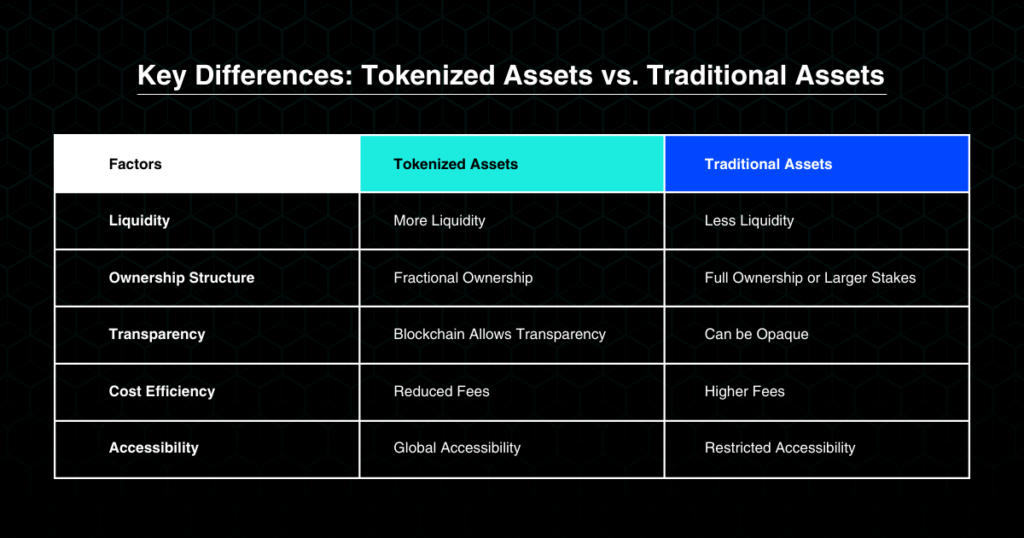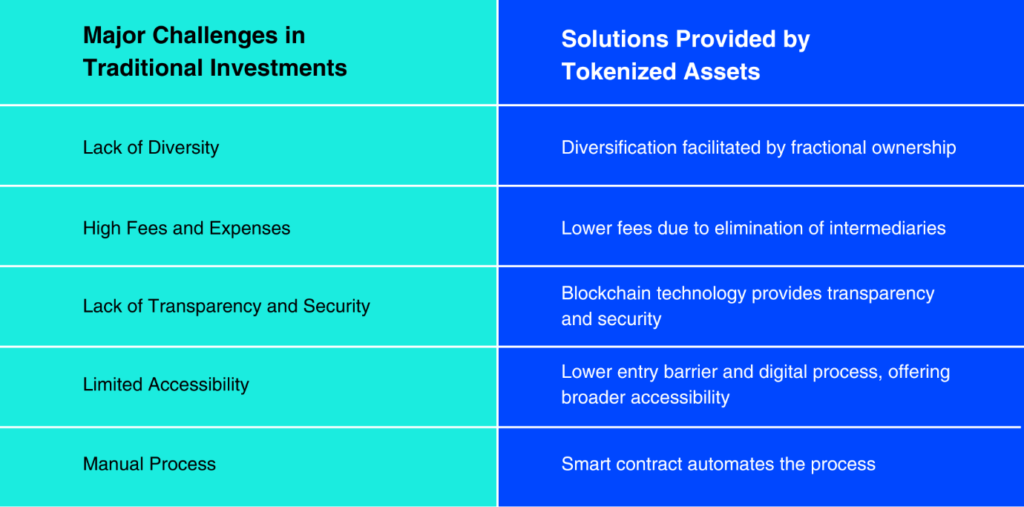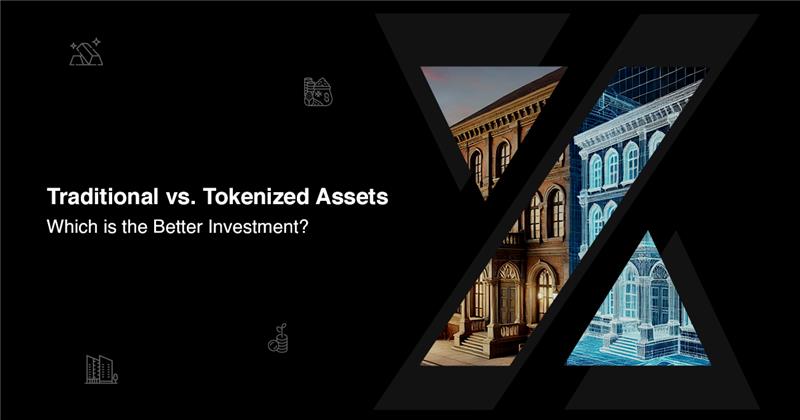Evolution of Investments
The investment domain has been evolving significantly with new technological additions, improving and reforming investments and trading in real-world assets. Earlier traditional investments deter small-scale investors from participating in exclusive assets. However, with the introduction of tokenization, investors are allowed the opportunities to engage in these assets. This shift from traditional investment to investments in tokenized assets has increased financial inclusion while democratizing the financial landscape. The blog aims to compare the investment opportunities between traditional and tokenized assets in multiple dimensions, the scope of investments in traditional vs. tokenized assets, and the benefits of asset tokenization.
Understanding Traditional Assets
Traditional assets incorporate already-established investment types including real estate, stocks, bonds, and commodities. Investments in traditional assets are favored by several investors and traders as they offer stability and potential growth for the long term. However, traditional assets require large amounts of capital with limited access to investors with low capital.
Common Forms of Traditional Assets
Real Estate:
Real estate is one of the most preferred kinds of traditional assets that offer stable income and capital appreciation. Traditional investment in real estate needs a significant amount of capital in both cases including residential properties and commercial properties. Nonetheless, investing in traditional real estate has its benefits such as:
- Rental income
- Property value appreciation
- Tax advantages
However, there are several challenges for investments in traditional assets including illiquidity in the market, fluctuation of the interest rate, delayed settlement due to several intermediaries, and local market conditions.

Stocks:
Stocks symbolize a company’s ownership and are among the most suitable assets for traditional investment. Advantages of investing in traditional stocks-
- Capital gains
- Dividends
- Relatively easy entry
However, traditional investments in stocks are subject to several challenges including:
- Market volatility
- Dependency on the company’s performance
- Economics trends and conditions
Bonds:
Bonds refer to debt securities that are issued by governments, municipalities, or corporations. They aim to raise capital and are relatively less risk-prone and are opt by mostly income-focused investors. The benefits of traditional investing in bonds include:
- Lower-risk investments
- Offers more stable returns
- Periodic interest payment
However, bonds are not entirely risk-free and are tied to a few issues like:
- Change in the interest rate
- Affected by inflation
- Credit risk
Commodities:
Commodities include raw materials and agricultural products like wheat, rice, gold, oil, and natural gas that can be sold or bought. Traditionally, these assets offer a hedge against inflation and a store of value. These assets have a tendency to perform well in times of economic uncertainty or currency devaluation. However, there are multiple challenges to investing in commodities:
- Price Volatility
- Storage and Transportation Costs
- Geopolitical and Economic Risk
- Regulatory and Legal Risks
- Market Liquidity

Comparing Tokenized Assets and Traditional Assets
Ownership Structure:
Tokenized Assets: Tokenization of real-world assets allows fractional ownership allowing investors to own a part or share of the tokenized assets in the form of digital tokens.
Traditional Assets: Traditional assets typically need full ownership of the asset or larger stakes in the assets, limiting it to the giant investors only.
Liquidity:
Tokenized Assets: They offer increased liquidity as they are easily purchased, sold, or invested on digital platforms. This facilitates smooth transactions without any need for the physical presence of the stakeholders.
Traditional Assets: They offer less liquidity and remain subject to market volatility and economic conditions.
Accessibility:
Tokenized Assets: They offer greater accessibility, facilitated by fractional ownership and a lower minimum investment threshold. Also, the reduction in geographical barriers offers ease of access.
Traditional Assets: They have mostly a high minimum investment threshold and requirement of the full ownership. Further, it also requires investors’ stakeholders to restrict full accessibility.
Transparency and Security:
Tokenized Assets: They are backed by blockchain technology that offers transparency and security, enhancing trust among the stakeholders.
Blockchain also provides an immutable record of transactions and ownership.
Traditional Assets: They rely on central authority and remain susceptible to fraud. Further, they are less secure and transparent due to the involvement of intermediaries and complex market structures.
Cost Efficiency:
Tokenized Assets: They do not require intermediaries like brokers and lawyers, reducing the fees. Also, smart contracts streamline the investment process.
Traditional Assets: They require higher fees due to dependency on intermediaries and manual processes for investment and trading.

Tokenized Assets as a Solution to Traditional Investment Problems
Lack of Diversity
Traditional assets- Mostly, traditional assets are owned completely, or investors must gain larger stakes. This restricts the ability of investors to diversify their investments.
Tokenized assets- They enable fractional ownership across a diverse range of asset classes, allowing investors to diversify their investments.
Higher Maintenance and Management Charges
Traditional assets- Typically require a higher charge due to involvement of the intermediaries and manual process.
Tokenized assets- They eliminate the need for intermediaries, and have automated processes, thus incurring lower charges.
Lack of Transparency and Security
Traditional assets- These assets have centralized authority and include several intermediaries, making the investments and assets vulnerable to risks of fraud.
Tokenized assets- They leverage blockchain technology to make the investments and assets secure and transparent by verifying their ownerships as well as transactions.
Limited Accessibility
Traditional assets- These assets have a higher minimum investment which deters small-scale investors.
Tokenized assets- fractional ownership allows lower minimum investment, offering investment opportunities to a wider range of investors.

As tokenization in real-world assets is gaining momentum in the market; several platforms allow their trading and investment. One such platform is STOEX.
STOEX is backed by KALP Distributed Ledger Technology (DLT) and strictly adhered to regulatory compliance, ensuring transparency and liquidity. With its structured approach, stringent security, and commitment to compliance, the platform offers an appealing option for diversified and efficient investing. Its regulation, security measures, focus on usability and customer-centric approach make it stand out as an accessible way of trading tokenized real-world assets.
Additionally, STOEX’s vision is to build a ground with reduced entry barriers and encourage a safe ecosystem for every individual interested in investing in the market. It pulls the strings of financial democratization by bridging the gap between investors and high-worth tokenized RWAs.
Closing Remarks
To conclude, traditional assets including real estate, commodities, stocks, and bonds are more established and stable forms of investments. However, they have several challenges as well such as a high minimum investment threshold, lack of diversification, illiquidity, and dependency on the intermediaries. These issues in traditional investment can be tackled by opting for investments in tokenized assets. Tokened assets are backed by blockchain technology, which allows a secure and transparent environment for investments and trading. As these concepts are still evolving, various platforms are adding to the layer of opportunities and options within these domains. One such option is STOEX, which allows investors to access the marketplace and trade effortlessly.
Key Takeaways
- Tokenized assets provide fractional ownership, increasing accessibility and liquidity compared to traditional assets.
- Traditional assets, while more established, have several challenges like high capital requirements, illiquidity, and accessibility.
- Blockchain technology enables transparency and efficiency in tokenized asset transactions.
- Key differences between tokenized assets and traditional assets.
- Solutions provided by the tokenized assets to the challenges of traditional investments.
FAQs
What are traditional assets?
Traditional assets include stocks, bonds, real estate, and commodities.
What are tokenized assets?
Tokenized assets are digital representations of real-world assets (like property, art, commodities, or shares) on a blockchain.
How do tokenized assets differ from traditional assets?
Tokenized assets are decentralized, and transparent, while traditional assets are often subject to central authority.
Are tokenized assets more liquid than traditional investments?
Yes, tokenized assets can be more liquid since they can be traded easily with 24/7 market access.
Which offers better diversification, traditional or tokenized assets?
Tokenized assets offer greater diversification as investors can easily access a wider range of asset classes globally.


